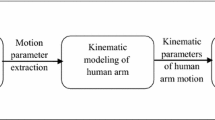Abstract
In this article, a new trajectory programming system that allows non-expert users to intuitively and efficiently program trajectories for robots is proposed. The system tracks a pen-shaped marker and obtains its position and orientation by processing the point cloud data of the workspace. A graphical user interface, which enables users to save and execute the acquired trajectory immediately after performing trajectory demonstration, is designed and developed for the system. The performance of the developed system is experimentally evaluated by using it to program trajectories for a UR5 robot. The results indicate that compared with traditional kinesthetic programming, the developed system has the potential of significantly reducing the ergonomic stress and workload of users. The system is developed based on the robot operating system, which facilitates its integration with different robot control systems.
















Similar content being viewed by others
References
Biggs G, MacDonald B (2003) A survey of robot programming systems. In: Proceedings of the Australasian conference on robotics and automation, Brisbane, Australia, pp 1–3
Ng CL, Ng TC, Nguyen TAN et al (2010) Intuitive robot tool path teaching using laser and camera in augmented reality environment. In: 2010 IEEE 11th international conference on control automation robotics and vision, Singapore, pp 114–119
Schaal S, Ijspeert A, Billard A (2003) Computational approaches to motor learning by imitation. Philos Trans R Soc Lond Ser B Biol Sci 358(1431):537–547
BillardAG Calinon S, Dillmann R (2016) Learning from humans. In: Siciliano Bruno, Khatib Oussama (eds) Springer handbook of robotics. Springer, Cham, pp 1995–2014
Helander MG, Landauer TK, Prabhu PV (2014) Handbook of human-computer interaction, 2nd edn. Elsevier, Amsterdam
ROS.org (2018) Powering the world’s robots. http://www.ros.org. Accessed 15 May 2019
Billard A, Calinon S, Dillmann R et al (2008) Robot programming by demonstration. Springer handbook of robotics. Springer, Berlin, pp 1371–1394
Landa-Hurtado LR, Mamani-Macaya FA, Fuentes-Maya M et al (2014) Kinect-based trajectory teaching for industrial robots. In: Pan-American congress of applied mechanics (PACAM), Santiago, Chile
Moe S, Schjølberg I (2013) Real-time hand guiding of industrial manipulator in 5 d of using microsoft kinect and accelerometer. In: 2013 IEEE RO-MAN, Gyeongju, Korea, pp 644–649
Lambrecht J, KleinsorgeM, KrügerJ (2011) Markerless gesture-based motion control and programming of industrial robots. In: International conference on emerging technologies and factory automation, Toulouse, France, pp 1–4
Zhang X, Zhou H, Cheng H et al (2015) Teaching-playback of robot manipulator based on human gesture recognition and motion tracking. In: 2015 IEEE international conference on robotics and biomimetics (ROBIO), Zhuhai, China, pp 1183–1188
Lambrecht J, Walzel H, Krüger J (2013) Robust finger gesture recognition on handheld devices for spatial programming of industrial robots. In: IEEE international workshop on robot and human communication, Gyeongju, South Korea, pp 99–106
Lambrecht J, Krüger J (2012) Spatial programming for industrial robots based on gestures and augmented reality. In: IEEE/RSJ international conference on intelligent robots and systems, Vilamoura, Portuga, pp 466–472
Ng CL, Ng TC, Nguyen TAN et al (2010) Intuitive robot tool path teaching using laser and camera in augmented reality environment. In: 11th International conference on control automation robotics and vision, Singapore, pp 114–119
Ong SK, Yuan ML, Nee AYC (2008) Augmented reality applications in manufacturing: a survey. Int J Prod Res 46(10):2707–2742
Pettersen T, Pretlove J, Skourup C et al (2003) Augmented reality for programming industrial robots. In: The second IEEE and ACM international symposium on mixed and augmented reality, Tokyo, Japan, pp 319–320
Pan Z, Polden J, Larkin N et al (2010) Recent progress on programming methods for industrial robots. Robot Comput Integr Manuf 28(2):87–94
Nguyen A, Le B (2013) 3D point cloud segmentation: a survey. In: 2013 6th IEEE conference on robotics, automation and mechatronics (RAM), Manila, Philippines, pp 225–230
Cheng HD, Jiang XH, Sun Y et al (2001) Color image segmentation: advances and prospects. Pattern Recognit 34(12):2259–2281
PCL - Point Cloud Library (PCL) (2019). http://pointclouds.org. Accessed 18 May 2019
Meer P, Mintz D, Rosenfeld A et al (1991) Robust regression methods for computer vision: a review. Int J Comput Vis 6(1):59–70
Rousseeuw PJ (1984) Least median of squares regression. J Am Stat Assoc 79(388):871–880
Bolles RC, Fischler MA (1981) A RANSAC-based approach to model fitting and its application to finding cylinders in range data. In: International joint conference on artificial intelligence, Vancouver, Canada, pp 637–643
Derpanis KG (2010) Overview of the RANSAC algorithm. Image Rochester NY 4(1):2–3
Grilli E, Menna F, Remondino F (2017) A review of point clouds segmentation and classification algorithms. In: International archives of photogrammetry, remote sensing and spatial information sciences, Nafplio, Greece
Qt (2019) Cross-platform software development for embedded & desktop. https://www.qt.io. Accessed 19 May 2019
MoveIt! Motion Planning Framework (2018). http://moveit.ros.org. Accessed 19 May 2019
rviz - ROS Wiki (2019). http://wiki.ros.org/rviz. Accessed 20 May 2019
Khoshelham K (2011) Accuracy analysis of kinect depth data. In: Proceedings of the ISPRS workshop laser scanning, Calgary, Canada, pp 133–138
Acknowledgments
This research was supported by the Major Projects of Guangzhou City of China (Grant Nos. 201907010012, 201704030091 and 201607010041), the Guangdong Innovative and Entrepreneurial Research Team Program (Grant No. 2014ZT05G132), Shenzhen Peacock Plan (Grant No. KQTD2015033117354154), the Major Projects of Guangdong Province of China (Grant No. 2015B010919002), the Major Projects of Dongguan City of China (Grant No. 2017215102008), and the Nansha District International Science and Technology Cooperation Project of Guangzhou City of China (Grant No. 2016GJ004).
Author information
Authors and Affiliations
Corresponding author
Rights and permissions
About this article
Cite this article
Zhang, HD., Liu, SB., Lei, QJ. et al. Robot programming by demonstration: a novel system for robot trajectory programming based on robot operating system. Adv. Manuf. 8, 216–229 (2020). https://doi.org/10.1007/s40436-020-00303-4
Received:
Revised:
Accepted:
Published:
Issue Date:
DOI: https://doi.org/10.1007/s40436-020-00303-4




